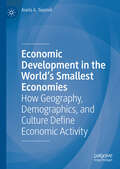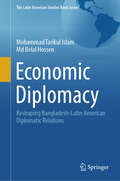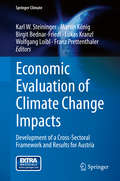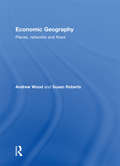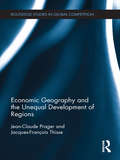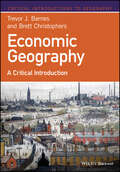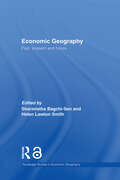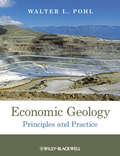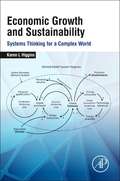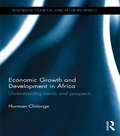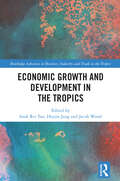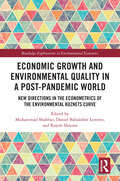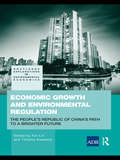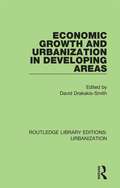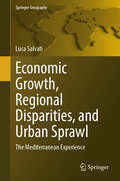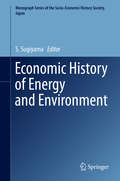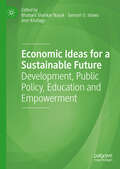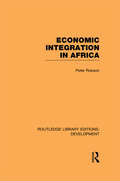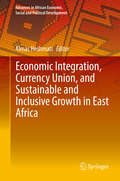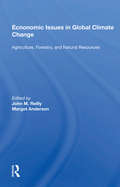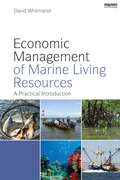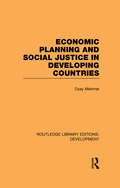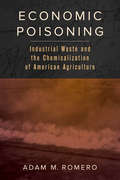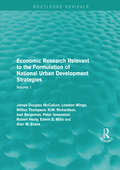- Table View
- List View
Economic Development in the World's Smallest Economies: How Geography, Demographics, and Culture Define Economic Activity
by Aneta A. TeperekThis book examines three fundamental factors that influence the economic growth and development of the world's 93 smallest economies, which together produced 1% of global GDP. The objective of the study is to ascertain whether the countries analysed possess the requisite environmental resources, human capital, and cultural conducive to economic development, and whether they effectively utilize their resources. Consequently, the location and elements of physical geography are analyzed, including climate, soils, landforms and geological structure from the perspective of mineral resources abundance as well as marine and inland water from the perspective of water resource abundance. The changes in population from 1970 to 2019 are studied and the factors determining them, which are natural increase and migration. Finally, the demographic structure are examined. The analysis of cultures, including religions and languages, is undertaken to identify cultural factors that either support or hinder economic growth and development. This book is designed for students and researchers engaged in the study of economic geography, geography, demography, and macroeconomics. It serves as a valuable resource for international organizations engaged in the analysis of countries across the globe.
Economic Diplomacy: Reshaping Bangladesh-Latin American Diplomatic Relations (The Latin American Studies Book Series)
by Mohammad Tarikul Islam Md Belal HossenEconomic diplomacy has become more notable in recent years, helping developing nations like Bangladesh maximise their national interests. Bangladesh is rapidly transitioning from a low-income to a middle-income nation, with the goal of reaching developed status by 2041. Bangladesh engages in international trade with almost every country. Nevertheless, a considerable amount of global trade demonstrates a strong reliance on specific nations. Decreasing trade dependence is required to transition from an emerging economy to a high-income, financially independent nation. Having gained its independence more than 50 years ago, Bangladesh has been slow to form bilateral partnerships and expand its economic activity. Consequently, Bangladesh remains dependent on China and India for imports, while focusing on America and Europe for exports. As a result of this economic interdependence, the dominant global powers enjoy the potential to pursue a proactive stance in the domestic affairs of Bangladesh. By taking steps to decrease its dependency on conventional trading partners, Bangladesh can increase the emphasis on non-traditional trading partners like Latin American and African countries. The formation and growth of a comprehensive economic diplomacy framework is required in this context. The aforementioned reasons generated the idea for a research investigation of Bangladesh's economic diplomacy with Latin America. Argentina now wishes to reopen their embassy in Bangladesh, spurred on by the extraordinary support the people of Bangladesh have shown for their country during the World Cup. In an effort to establish a Mexican embassy in Dhaka, Mexican Foreign Minister Marcelo Ebrard Casaubon is expected to visit the city in March as part of a high-level group. This study shows that geographical distance and cultural differences do not have a substantial impact on building a market position in the Latin American region. Promoting Bangladesh through public diplomacy in the region can assist the country in increasing its portion of international trade. However, this requires a suitable framework for Economic Diplomacy. The book examines prospective economic diplomacy methods for Bangladesh. This book offers fresh perspectives on various facets of Bangladesh's expanding trade relations with Latin America.
Economic Evaluation of Climate Change Impacts
by Birgit Bednar-Friedl Karl W. Steininger Martin König Lukas Kranzl Wolfgang Loibl Franz PrettenthalerThis volume deals with the multifaceted and interdependent impacts of climate change on society from the perspective of a broad set of disciplines. The main objective of the book is to assess public and private cost of climate change as far as quantifiable, while taking into account the high degree of uncertainty. It offers new insights for the economic assessment of a broad range of climate change impact chains at a national scale. The framework presented in the book allows consistent evaluation including mutual interdependencies and macroeconomic feedback. This book develops a toolbox that can be used across the many areas of climate impact and applies it to one particular country: Austria.
Economic Geography
by Andrew Wood Susan RobertsThe turbulence of the current times has dramatically transformed the world's economic geographies. The scale and scope of such changes require urgent attention. With intellectual roots dating to the nineteenth century, economic geography has traditionally sought to examine the spatial distributions of economic activity and the principles that account for them. More recently, the field has turned its attention to a range of questions relating to: globalization and its impact on different peoples and places; economic inequalities at different geographic scales; the development of the knowledge-based economy; and the relationship between economy and environment. Now, more than ever, the changing fortunes of peoples and places demands our attention. Economic Geography provides a stimulating and innovative introduction to economic geography by establishing the substantive concerns of economic geographers, the methods deployed to study them, the key concepts and theories that animate the field, and the major issues generating debate. This book is the first to address the diverse approaches to economic geography as well as the constantly shifting economic geographies on the ground. It encompasses traditional approaches, albeit from a critical perspective, while providing a thorough, accessible and engaging examination of the concerns, methods and approaches of the 'new economic geography'. This unique introductory text covers the breadth of economic geography while engaging with a range of contemporary debates at the cutting-edge of the field. Written in an accessible and lucid style, this book offers a thorough and systematic introductory survey. It is enhanced by pedagogical features throughout including case studies dealing with topics ranging from the head office locations of the Fortune 500, Mexico's maquiladoras to China's investments in Southern Africa. This book also contains exercises based on the key concepts and annotated further reading and websites.
Economic Geography and the Unequal Development of Regions (Routledge Studies in Global Competition)
by Jacques-François Thisse Jean-Claude PragerBehind the mystery of economic growth stands another mystery: why do some places fare better than others? Casual evidence shows that sizable differences exist at very different spatial scales (countries, regions and cities). This book aims to discuss the main economic reasons for the existence of peaks and troughs in the spatial distribution of wealth and people, with a special emphasis on the role of large cities and regional agglomerations in the process of economic development.
Economic Geography: A Critical Introduction (Critical Introductions to Geography #1)
by Brett Christophers Trevor J. BarnesThis volume in the celebrated Critical Introductions to Geography series introduces readers to the vibrant discipline of economic geography. The authors provide an original definition of the discipline, and they make a strong case for its vital importance in understanding the dynamic interconnections, movements, and emerging trends shaping our globalized world. Economic Geography addresses the key theories and methods that form the basis of the discipline, and describes its “communities of practice” and relations to related fields including economics and sociology. Numerous illustrative examples explore how economic geographers examine the world and how and why the discipline takes the forms it does, demonstrating the critical value of economic geography to making sense of globalization, uneven development, money and finance, urbanization, environmental change, and industrial and technological transformation. Engaging and thought-provoking, Economic Geography: A Critical Introduction is the ideal resource for students studying across a range of subject areas, as well as the general reader with an interest in world affairs and economics.
Economic Geography: Past, Present and Future (Routledge Studies in Economic Geography)
by Sharmistha Bagchi-Sen Helen Lawton SmithThe impact of economic geography both within and beyond the wider field of geography has been constrained in the past by its own limitations. Drawing together the work of several eminent geographers this superb collection assesses the current state of knowledge in the sub discipline and its future direction. In doing so, the contributors show how economic geographers have offered explanations that affect places and lives in the broader context of the global economy. Offering a discussion of theoretical constructs and methodologies with the purpose to show the need to combine different approaches in understanding spatial (inter) dependencies, contributors also demonstrate the need to engage with multiple audiences, and within this context they proceed to examine how geographers have interfaced with businesses and policy. This excellent collection moves economic geography from a preoccupation with theory towards more rigorous empirical research with greater relevance for public policy. With excellent breadth of coverage, it provides an outstanding introduction to research topics and approaches.
Economic Geography: Past, Present and Future (Routledge Studies in Economic Geography)
by Sharmistha Bagchi-Sen Helen Lawton SmithThe impact of economic geography both within and beyond the wider field of geography has been constrained in the past by its own limitations. Drawing together the work of several eminent geographers this superb collection assesses the current state of knowledge in the sub discipline and its future direction. In doing so, the contributors show how economic geographers have offered explanations that affect places and lives in the broader context of the global economy. Offering a discussion of theoretical constructs and methodologies with the purpose to show the need to combine different approaches in understanding spatial (inter) dependencies, contributors also demonstrate the need to engage with multiple audiences, and within this context they proceed to examine how geographers have interfaced with businesses and policy.This excellent collection moves economic geography from a preoccupation with theory towards more rigorous empirical research with greater relevance for public policy. With excellent breadth of coverage, it provides an outstanding introduction to research topics and approaches.
Economic Geology
by Walter L. PohlHumanity's ever-increasing hunger for mineral raw materials, caused by a growing global population and ever increasing standards of living, has resulted in economic geology becoming a subject of urgent importance.This book provides a broad panorama of mineral deposits, covering their origin and geological characteristics, the principles of the search for ores and minerals, and the investigation of newly found deposits. Practical and environmental issues that arise during the life cycle of a mine and after its closure are addressed, with an emphasis on sustainable and "green" mining.The central scientific theme of the book is to place the extraordinary variability of mineral deposits in the frame of fundamental geological processes.The book is written for earth science students and practicing geologists worldwide. Professionals in administration, resource development, mining, mine reclamation, metallurgy, and mineral economics will also find the text valuable.Economic Geology is a fully revised translation of the the fifth edition of the German language text Mineralische und Energie-Rohstoffe.Additional resources for this book can be found at: www.wiley.com/go/pohl/geology.The author's website can be found at: http://www.walter-pohl.com.
Economic Growth And Sustainability: Systems Thinking For A Complex World
by Karen HigginsHow to sustain our world for future generations has perplexed us for centuries. We have reached a crossroads: we may choose the rocky path of responsibility or continue on the paved road of excess that promises hardship for our progeny. Independent efforts to resolve isolated issues are inadequate. Different from these efforts and from other books on the topic, this book uses systems thinking to understand the dominant forces that are shaping our hope for sustainability. It first describes a mental model - the bubble that holds our beliefs - that emerges from preponderant world views and explains current global trends. The model emphasizes economic growth and drives behavior toward short-term and self-motivated outcomes that thwart sustainability. The book then weaves statistical trends into a system diagram and shows how the economic, environmental, and societal contributors of sustainability interact. From this holistic perspective, it finds leverage points where actions can be most effective and combines eight areas of intervention into an integrated plan. By emphasizing both individual and collective actions, it addresses the conundrum of how to blend human nature with sustainability. Finally, it identifies primary three lessons we can learn by applying systems thinking to sustainability. Its metaphor-rich and accessible style makes the complex topic approachable and allows the reader to appreciate the intricate balance required to sustain life on Earth.
Economic Growth and Development in Africa: Understanding trends and prospects (Routledge Studies in African Development)
by Horman ChitongeIn recent years, Africa has undergone the longest period of sustained economic growth in the continent’s history, drawing the attention of the international media and academics alike. This book analyses the Africa Rising narrative from multidisciplinary perspectives, offering a critical assessment of the explanations given for the poor economic growth and development performance in Africa prior to the millennium and the dramatic shift towards the new Africa. Bringing in perspectives from African intellectuals and scholars, many of whom have previously been overlooked in this debate, the book examines the construction of Africa’s economic growth and development portraits over the years. It looks at two institutions that play a vital role in African development, providing a detailed explanation of how the World Bank and the IMF have interpreted and dealt with the African challenges and experiences. The insightful analysis reveals that if Africa is rising, only 20-30 per cent of Africans are aboard the rising ship, and the main challenge facing the continent today is to bring on board the majority of Africans who have been excluded from growth. This book makes the complex, and sometimes confusing debates on Africa’s economic growth experience more accessible to a wide range of readers interested in the Africa story. It is essential reading for students and researchers in African Studies, and will be of great interest to scholars in Development Studies, Political Economy, and Development Economics.
Economic Growth and Development in the Tropics (Routledge Advances in Business, Industry and Trade in the Tropics)
by Jacob Wood Sook Rei Tan Haejin JangThe living standards and scale of development around the world are vastly unequal. One notable observation is that much of the poverty-stricken area is located between the tropics of Cancer and Capricorn. By contrast, affluent nations are situated in more temperate zones. Such a phenomenon gives weight to the geography hypothesis that seeks to explain the occurrence of global economic inequality, by placing an emphasis on the importance of natural elements such as location and climate in determining the economic conditions of a nation. This book concentrates exclusively and in depth on the key economic phenomena and factors which shape tropical economies today. It examines contemporary economic problems confronting the tropical countries and provides policy recommendations that align with the United Nations’ Sustainable Development Goals set in the 2030 Agenda. It contains research works and case studies of tropical economies that are related to the area of development and environment economics. The book’s themes range from economic growth, poverty reduction, income inequality, economic globalization, international trade, capital flow, financial development, and institutional development to environmental sustainability within the Tropics. Recognizing the dynamism and diversity of the tropics, the book encompasses empirical and policy analyses that address the key economic issues and challenges in the region so as to provide an important platform from which new policymaking initiatives can flourish. This book will draw readership primarily from the fields of economics and public policy, particularly under the subject areas of development and environment economics, as well as discussions in the sustainability policy space.
Economic Growth and Environmental Quality in a Post-Pandemic World: New Directions in the Econometrics of the Environmental Kuznets Curve (Routledge Explorations in Environmental Economics)
by Muhammad Shahbaz, Daniel Balsalobre Lorente, and Rajesh SharmaIn response to the damage caused by a growth-led global economy, researchers across the world started investigating the association between environmental pollution and its possible determinants using different models and techniques. Most famously, the environmental Kuznets curve hypothesizes an inverted U-shaped association between environmental quality and gross domestic product (GDP). This book explores the latest literature on the environmental Kuznets curve, including developments in the methodology, the impacts of the pandemic, and other recent findings. Researchers have recently broadened the range of the list of drivers of environmental pollution under consideration, which now includes variables such as foreign direct investment, trade expansion, financial development, human activities, population growth, and renewable and nonrenewable energy resources, all of which vary across different countries and times. And in addition to CO2 emissions, other proxies for environmental quality – such as water, land, and ecological footprints – have been used in recent studies. This book also incorporates analysis of the relationship between economic growth and the environment during the COVID-19 crisis, presenting new empirical work on the impact of the pandemic on energy use, the financial sector, trade, and tourism. Collectively, these developments have improved the direction and extent of the environmental Kuznets curve hypothesis and broadened the basket of dependent and independent variables which may be incorporated. This book will be invaluable reading for researchers in environmental economics and econometrics.
Economic Growth and Environmental Regulation: China's Path to a Brighter Future (Routledge Explorations In Environmental Economics Ser. #20)
by Tim Swanson Tun LinThis volume assembles a group of eminent scholars to look at the problem of growth and environment from the perspective of environmental regulation. The questions addressed are: How does economic growth interact with regulation, and what are the best approaches to regulation in use today? The context for the volume is the current situation in China, where twenty years of rapid growth have created a situation in which there are both demands for environmental regulation and needs for choosing a future development path. The advent of "A Macro-Environmental Strategy" for China presents an opportunity to ask how and why China should introduce regulation into its management of its development. The volume includes contributions from leading Chinese experts and established environmental economists from other countries including Timo Goeschl, Ben Groom and Andreas Kontoleon. The volume looks at both the demand side of environmental regulation and the supply side. The demand side of regulatory intervention examines how regulation operates to supplement existing resource-allocation mechanisms, via effective demand aggregation and implementation mechanisms. The supply side of regulation examines how regulation operates to guide industrial growth down particular pathways, in the pursuit of managed development. Both sides of environmental regulation involve the important issue of implementation and enforcement. This volume will be of most value to academics and scholars of environmental economics, growth economics, the Chinese economy and policy-makers of environmental regulations.
Economic Growth and Urbanization in Developing Areas (Routledge Library Editions: Urbanization #2)
by David Drakakis-SmithOriginally published in 1990, Economic Growth and Urbanization in Developing Areas is a wide-ranging collection of research studies focused on urban economic growth at various levels of urban and national development. The contributions range from studies of peripheral Third World states, such as Fiji and Malaysia, to countries of the so-called semi-periphery, such as Spain, South Africa, and Northern Australia. In addition the authors cover a variety of thematic topics within the framework of urban economic development, from the provision of basic services such as housing and food, to the functional preservation of historic cores, and the impact of economic change on family structure.
Economic Growth, Regional Disparities, and Urban Sprawl: The Mediterranean Experience (Springer Geography)
by Luca SalvatiThis book gives a unique description of urban geography of Europe and specifically, Southern Europe, and provides a fine guide to urban complexity and resilience in the light of metropolitan sustainability. Sprawl is a multifaceted phenomenon that needs to be quantified with distinct measures and during an enough long observation period. Landscape change is recognized to be a relevant topic when studying the impact of urban growth and sprawl on peri-urban land. In the kaleidoscopic panorama of urban Europe, Mediterranean cities represent an element that breaks with the stereotypes of the 'old continent' urbanities. Originally developed according to a purely mono-centric structure, which grew radio-centrically with the progressive addition of satellite urban areas, Mediterranean cities have more recently oriented their growth path towards dispersed settlement models. This resulted in a high consumption of land, in contrast with the 'judicious compactness' that characterized the tumultuous development of the cities at least in the first three decades after World War II. This book tells, through narratives, photographs, qualitative-quantitative descriptions of landscapes, maps and indicators, the transition from a compact model—`judiciously mono-centric' and `land saving'—to contemporary sprawl, with practical implications in economic geography. The environmental, social and economic implications of this phenomenon, far from being a unique characteristic of the European Mediterranean region, have been also discussed, and the planning and policy implications addressed with respect to the individual ecological problems faced from time to time.
Economic History of Energy and Environment
by S. SugiyamaThis book is the first volume of a monograph series published by the Socio-Economic History Society, Japan. The purpose of the series is to make works by Japanese scholars accessible to a wider readership and to increase the knowledge of scholars in this field, particularly in relation to Asia. This volume includes four chapters on energy and the environment of Japan, China and Britain and four short book reviews on recent academic works published in Japanese and English. The four chapters cover the following topics: the relationship between deforestation and the development of the silk reeling industry in a district of Nagano Prefecture (central Japan) from the 1870s to the 1900s and the subsequent shift from firewood to coal; the importance of timber supplies for the development of industry as illustrated by a case study on the supply of timber for use as rail sleepers in the Japanese national railway network during the prewar period; a methodological survey of the history of ecology and the environment in China; and an analysis of the British Smoke Nuisance Abatement Act of 1821 as a measure that incorporated the interests of politicians, landlords and industrialists.
Economic Ideas for a Sustainable Future: Development, Public Policy, Education and Empowerment
by Samuel O. Idowu Amr Khafagy Bhabani Shankar NayakThis volume examines the concept of economic sustainability through the everyday practices of education, production, distribution, consumption, economic development, and public policy. It explores the economic systems and processes shaped by capitalism and how commodification has led to uneven and unsustainable development. Particular attention is given to how ideas of sustainability are constructed through education and how, without a critique of capitalism, these discussions often overlook the exploitation and commodification of both nature and human beings. This book advocates for a new paradigm based on socio-ecological transition that places sustainability and equity at the core of economic development and the political economy. It will be valuable to students and researchers interested in public policy, sustainable development, and the political economy.
Economic Integration in Africa (Routledge Library Editions: Development)
by Peter RobsonFirst published in 1968, this reissue is a study of contemporary international economic policy, with particular emphasis upon economic integration as a means of bringing about a faster rate of economic progress and of helping to overcome poverty. Peter Robson’s book is a study of the rationale of common markets and other forms of economic integration among African states and of their operation in practice. The book will be of great value to those concerned with administering or assessing integration schemes in Africa and indeed in less developed areas throughout the world. In addition, it is an important contribution to the field of development economics.
Economic Integration, Currency Union, and Sustainable and Inclusive Growth in East Africa
by Almas HeshmatiThis edited volume focuses on economic integration, currency union, and sustainable and inclusive growth in East Africa. It consists of twelve interrelated studies that provide a comprehensive picture of the state and determinants of economic development and cooperation among countries in East Africa, such as Burundi, Ethiopia, Kenya, Rwanda and Tanzania. The contributions are grouped into five parts: economic integration and its effects on trade; common currency and exchange rate; research, innovation, and knowledge, and shadow economics and corruption; inclusive and sustainable growth; and the conflict-growth nexus and reconstruction. This book will appeal to scholars and decision makers looking for the necessary tools and determinants of economic development and cooperation in East Africa.
Economic Issues In Global Climate Change: Agriculture, Forestry, And Natural Resources
by John M. Reilly Margot AndersonThis book provides a snapshot on economic thinking about global change and provides a starting point for researchers for evaluating the economics of global change in the context of agriculture, forestry, and resource issues. It attempts to rectify the scarcity of economic analysis in global change.
Economic Management of Marine Living Resources: A Practical Introduction
by David WhitmarshThis textbook has two main objectives. Firstly, it outlines the problems associated with the management and conservation of marine living resources, with particular attention given to the twin concepts of economic value and sustainability. It demonstrates the contribution that economics can make to understanding these problems as well as helping to frame policies to mitigate them. Secondly, it looks in detail at the key methods that may be used to collect and analyse socio-economic data, oriented towards the information needs of decision makers and stakeholders involved in fisheries management. Together, these two objectives address the question: how does society make the best use of its marine living resources?
Economic Planning and Social Justice in Developing Countries
by Ozay MehmetFirst published in 1978, this book was written at a time when belief was high in Western-guided economic development of the emerging countries. The success of Marshall Plan in war-torn Europe generated a US-led optimism that, with generous inflows of aid and technical assistance, the Third World could be won over in the Cold War. The author’s direct experience as a young academic economist in Cyprus, Malaysia, Uganda and Liberia led him to question this general optimism: the reality on the ground in the developing world did not seem to match Western optimism. Theories and blueprints, made in the West, did not fit the requirements of developing countries. Higher production and better income distribution were inseparable twin objectives of developing nations. That meant, production of a higher national output must at the same time promote social justice. Investment must create adequate jobs so that new entrants into rapidly expanding labor force could be gainfully employed. Yet, the dominant (Western) theories of development at the time, in particular the Trickle Down Theory of Growth, prescribed "Growth First, Distribution Later" strategy. Similarly, Import Substitution Industrialization theories were emphasized at the expense of export-led growth. Dualistic Growth theories preached urban-biased, anti-rural development. This book was written as a rebuttal of such faulty theorizing and misguided professional technical assistance and the book’s message is no less valid today than in the 1970’s.
Economic Poisoning: Industrial Waste and the Chemicalization of American Agriculture (Critical Environments: Nature, Science, and Politics #8)
by Adam M. RomeroThe toxicity of pesticides to the environment and humans is often framed as an unfortunate effect of their benefits to agricultural production. In Economic Poisoning, Adam M. Romero upends this narrative and provides a fascinating new history of pesticides in American industrial agriculture prior to World War II. Through impeccable archival research, Romero reveals the ways in which late nineteenth- and early twentieth-century American agriculture, especially in California, functioned less as a market for novel pest-killing chemical products and more as a sink for the accumulating toxic wastes of mining, oil production, and chemical manufacturing. Connecting farming ecosystems to technology and the economy, Romero provides an intriguing reconceptualization of pesticides that forces readers to rethink assumptions about food, industry, and the relationship between human and nonhuman environments.
Economic Research Relevant to the Formulation of National Urban Development Strategies: Volume 1 (Routledge Revivals)
by Robert Healy Alan W. Evans Edwin S. Mills H.W. Richardson James Douglas McCallum Lowdon Wingo Wilbur Thompson Joel Bergsman Peter GreenstonOriginally published in 1971, this volume contains papers invited for a conference on economic research relevant to national urban development held in September of the same year. The conference pulled together researchers from both the United Kingdom and the United States who were interested in economic research on key issues of both countries’ management of their urban areas. Papers are varied from those in the early stages of research to those whose research has been completed and all provide an insight into the increase of urbanisation present in the first world. This title will be of interest to students of environmental studies and economics.
